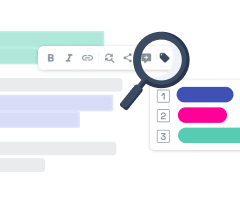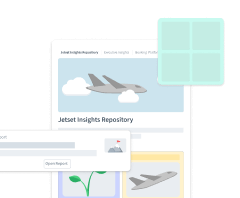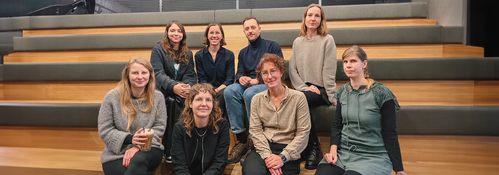
Europace's Journey to a Centralized Research Repository

The Challenges
- Research procedures and documentation lacked consistency.
- Data and insights were scattered across different tools.
- Stakeholders outside the UX team had difficulty accessing and leveraging research insights
The Solution
- A sophisticated taxonomy to accommodate both universal and project-specific needs.
- A centralized place to store research that is intuitive to use.
- An affordable tool that supports the desired number of users.
The Results
- A research workflow that is both flexible and structured.
- Every aspect of conducting a research project is consolidated in an all-in-one solution.
- Research siloes are a thing of the past and findings are easily accessible.
About the company
Meet Europace, a wholly owned subsidiary of Hypoport SE, and Germany's largest transaction platform for real estate financing, building savings products, and installment loans.
For more than two decades, Europace has been developing consumer-centric solutions in collaboration with partners in the banking, insurance, and financial sales sectors. Their goal is to empower people to take control of their financial decisions and to make financing a natural part of every life. This commitment is supported by their ongoing UX research efforts.
Europace's UX team, consisting of eight researchers across seven product teams, is led by Janine Hintze. She has played an essential role in Europace's journey and shared her insights with us on how the introduction of a research repository has transformed Europace's approach to user research.

The Challenges
Prior to introducing a research repository, Europace faced a few significant challenges that required a more structured approach to its user research efforts. When Janine hopped on board the UX team, her mission was to enhance the efficiency and organization of the company's user research processes. She kicked off the journey by conducting a comprehensive assessment of Europace's current research landscape.
Europace operates through interdisciplinary teams with researchers distributed across product teams. Upon closer examination, it became clear that the main challenge arose from the fact that these teams functioned rather independently, each developing its own methods and procedures for conducting, analyzing, and documenting research.
While autonomy within teams can be beneficial and refreshing, it also has its fair share of quirks. Research procedures, data interpretation, and the overall quality of the research varied widely among the teams. Additionally, research data and documents were scattered across different locations, making it feel like a scavenger hunt and further complicating access and knowledge sharing. Documents were found in various forms, including Miro boards, Jira tickets, or buried within team members' personal notes.
Each team had developed its unique approach to managing research data, which was effective for their individual needs but not helpful for cross-team collaboration, data integration, and insight sharing. This unstructured system made it difficult for anyone outside the UX team to leverage critical insights and information, which were often lost or overlooked.
„No one from the outside was able to reabsorb insights that were already there; you simply couldn't rediscover things, so it was truly a mishmash.“
Recognizing the urgent need for a more organized and centralized solution, Janine began to explore the world of research repositories. Repositories had already been on her radar as a potential solution and the concept behind it was right in sync with Europace's goal of storing and structuring user research data more effectively.
The Solution
The decision to introduce a research repository marked a crucial step in addressing the challenges Europace faced. Let's take a look at how the transition from a fragmented and uncoordinated research landscape to a centralized knowledge management system has worked for Europace.
Janine started the journey by exploring various research tools, Condens being one of them. Her goal was to find a tool that could centralize and streamline research efforts, fostering better collaboration, and more efficient knowledge sharing across the organization. As the UX team is decentralized and researchers operate independently within the product teams, this called for a repository that was not just efficient but flexible and adaptable too.
It's likely no surprise for you that Europace has opted for Condens as its research repository. So, keep reading to learn how Janine's decision was formed:
Ease of Use
Janine was impressed by the approachable interface and straightforward usability of Condens. She perceived the tool as user-friendly, with an intuitive interface and functionality that appealed to the team. When testing Condens along with her colleagues, Janine appreciated the balance between simplicity and sophistication, finding the tool to be neither overly basic nor needlessly complex.
„Condens is very easy to use. I understood directly what you can do, where you can find stuff, and how it works. It looks kind of easy, but it’s not too easy.“
Affordability
The affordability of the tool also played an important role in the decision-making process. Europace was looking for a solution that aligned with their needs, wouldn’t break the bank, and was fairly priced to accommodate the desired number of researchers and stakeholders to be onboarded onto the tool.
Data Privacy and Security
Data protection and security were top priorities, especially since Europace is operating in the financial market. The fact that Condens has servers located exclusively in the European Union, ensuring compliance with data protection regulations such as GDPR, was a key requirement for adoption. In addition, the tool's ability to operate without storing more data than necessary was critical to Europace.
Long-term Usability and Integration
Janine further considered the long-term utility of the tool. As she navigated through various repositories, her focus was on harnessing global tags to unify insights from diverse projects spanning different products. Yet, as the journey unfolded, she realized that creating a universal taxonomy for teams with such unique products was a challenge. Consequently, the approach shifted, and each team was encouraged to customize the tool for their needs and to create product-specific taxonomies that could be used for cross-project analysis. Here's a glimpse of their global taxonomy:
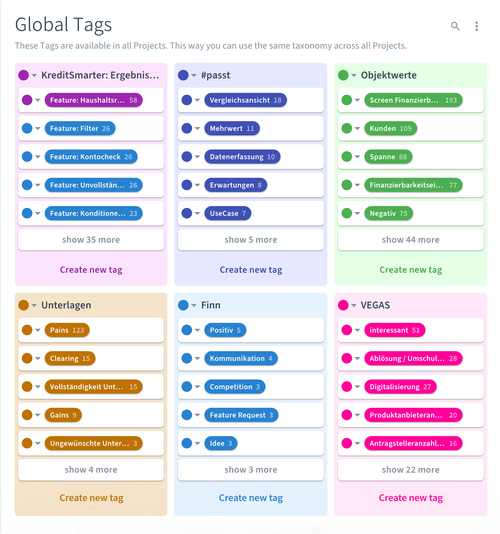
The Implementation
Once convinced of Condens' value, Janine introduced the tool to a small group of research colleagues for feedback and refinement. The goal was to gain commitment from all researchers and ensure that the tool's advantages were understood. Janine took the initiative to showcase the tool to her colleagues, encouraging them to experiment and gain practical experience. She followed a hands-on approach and intended to strike a balance between demonstrating the tool's capabilities and allowing others to try it out.
In the early stages of the adoption phase, the focus was on integrating existing projects into the tool. The team imported and maintained these projects, ensuring a smooth transition and starting point for all team members.
Once the projects were integrated, the researchers found themselves in a position to explore the tool's functionality and its practical applications in the context of their research. The final phase of their adoption strategy involved announcing the tool's integration within the organization and embracing the adoption among stakeholders of the organization.
Janine shared that the adoption of the tool varied among different roles within the organization. Product managers were invited along with researchers and embraced the tool wholeheartedly. They were proactively engaging with the tool, asking questions, and providing feedback. In contrast, other teams, such as developers or those with other responsibilities, showed a slower adoption rate. Janine acknowledges that these teams were not yet 100% integrated into the tool, primarily because they didn't require it daily.
To address the varying degrees of adoption, the UX team introduced an internal research-sharing system. Whoever wanted access to the insights had to have access to Condens, which was the single source of truth for user insights. Researchers would send out links and empower other people to look at them.
„If you want access to the research, then you must have access to the research repository. So I didn't publish it as a PDF or anything like that in order to get more people to try out Condens.“
Europace also set up a Slack integration that would notify everyone in the channel as soon as a new Artifact (in other words, insight) was published. And this is how it looks in Slack:
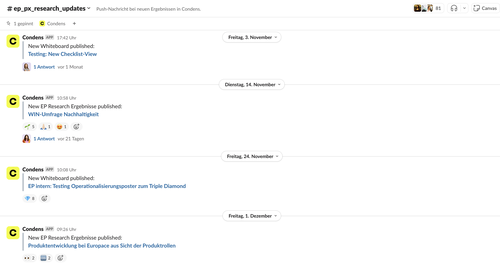
Overall, Janine summed the implementation up with a big smile. The adoption went smoothly, and researchers and stakeholders alike recognized the advantages and efficiency that Condens brought. With more than 120 stakeholders on board, the number speaks for itself.
The Results
Condens has swiftly become the go-to tool for every user research project at Europace and has proven to be a game-changer. From exploratory interviews and testing to satisfaction surveys and internal employee research, Europace is relying on Condens for a wide range of projects. Let's go through the significant changes it has brought about!
All-In-One Solution for Streamlined User Research
For Europace, Condens is the all-in-one solution for consolidating every aspect of a research project, from the analysis to storage in a centralized repository. It's not limited to simplifying specific tasks, such as drafting protocols or transcriptions, but it encompasses and supports the entire research process journey. Thanks to Condens, the UX team is now all about efficiency and teamwork!
„You can really map the entire process of a research project, and this not only simplifies functions like transcription but also provides support through the entire workflow. I just think that's really good.“
Enhanced Research Structure
Condens has helped Europace strike a perfect balance between flexibility and standardization in its research workflows. It provides the essential foundation of a consistent workflow while allowing teams to customize their approach. Janine and her team have set up project and evaluation templates, as well as guidelines in Condens, simplifying the workflow and ensuring everyone stays on the same page. Yet, each team can add its unique twist on how they use the tool, embracing individual working styles and preferences.
Time Savings through Consolidation
Condens saves researchers time by consolidating multiple tools into one. How? Janine shared an example: She loves the Whiteboard in Condens, which makes it easier to break down and evaluate information in new ways. Here are two examples that Janine shared:

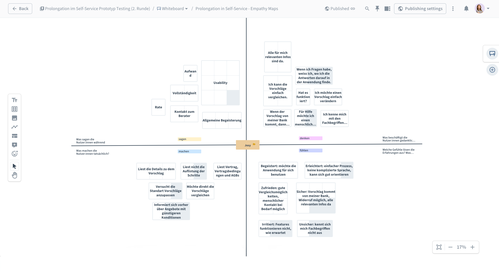
Thanks to this feature, the challenge of ensuring that stakeholders engage with and comprehend lengthy reports is a thing of the past. The whiteboard allows for an interactive and visually appealing way to present and share information. In this respect, features from tools like Miro fade into the background. Condens offers the freedom to work seamlessly within its interface, reducing the need for juggling multiple applications. As Janine points out, it's not just a place to store data, it's a hub for collaboration, analysis, and innovation.
„I think it's really cool that this report form can break out and with the whiteboard, you can evaluate and process things in a different way.“
Improved Collaboration and Knowledge Sharing
Condens serves as Europace's central platform for collaboration and knowledge sharing. It eliminates silos, ensuring that everyone in the company can easily access user research findings. Additional tool integrations, such as Slack, make it easy to share and retrieve research data and integrate it into existing workflows.
In a nutshell, Condens has transformed the way user researchers conduct projects at Europace, simplifying and enhancing the research process. It centralizes efforts, offers flexibility and standardization, saves time and resources, and promotes collaboration and knowledge sharing. It's a valuable tool that has made research at Europace more efficient and enjoyable. Janine is also excited about the ongoing developments in Condens. The constant flow of new product ideas and improvements adds value exactly where it's needed in the research workflow.
Final Advice
Janine shared four valuable best practices for successfully introducing a research repository, and we're excited to pass them along to you:
1) Involve Researchers from the Start
Ensure that researchers are engaged right from the beginning. Give them the opportunity to explore the repository to see how it aligns with their needs and working processes.
2) Prioritize Design and Documentation
Pay attention to how research is designed and documented within the repository. Consider questions like the repository's purpose and its practical usage.
3) Evaluate Alignment and Utility
Assess how well the repository aligns with your organization's structure and how seamlessly it can be integrated into your existing workflows, including any tools you're currently using.
4) Dedicate Time to Experimentation and Reflection
Allocate time for thorough testing and reflection on the repository's utility, even if it initially appears straightforward to use. Continuous evaluation is key to success.
Want to find out more about the concept of UX research repositories? Explore Condens' introductory guide on research repositories and read the article about what a UX research repository can do for you.

